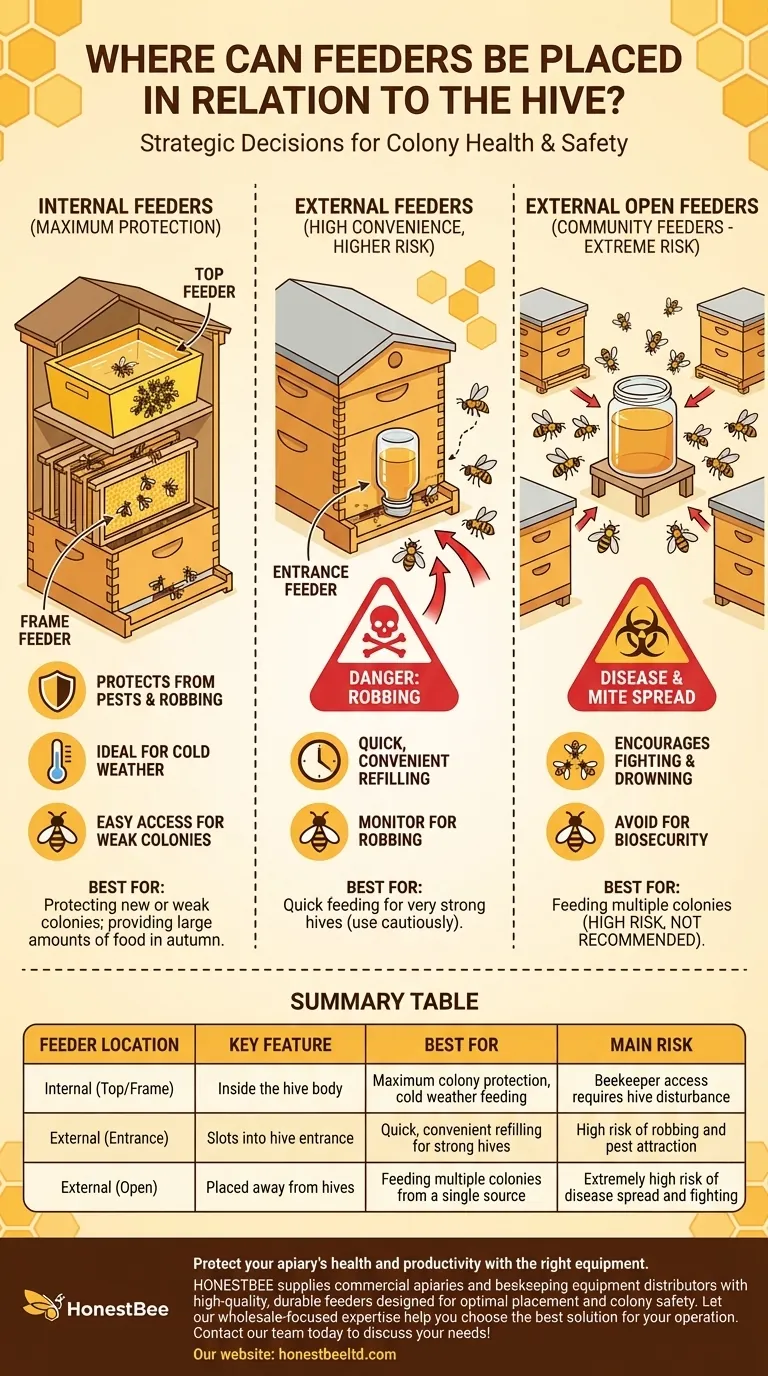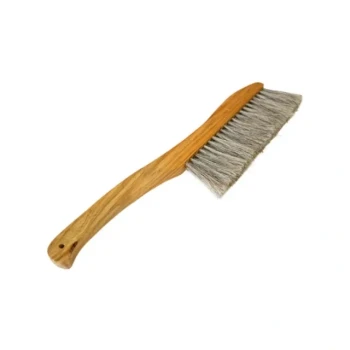In short, bee feeders can be placed inside, outside, or at the entrance of the hive. Each location serves a different purpose and comes with its own set of advantages and risks. The placement can be above or below the bee cluster inside the hive, attached to the side, or slotted directly into the main entrance.
Choosing a feeder's location is a strategic decision that directly impacts your colony's health and safety. The central conflict is between beekeeper convenience (external feeders) and hive protection (internal feeders).

Internal Feeders: Maximum Protection
Placing a feeder inside the hive is the safest method for the colony. It protects the food source from outside pests, robber bees from other colonies, and keeps the syrup warm and accessible during cooler weather.
Top Feeders
These feeders are placed on top of the uppermost hive body, directly beneath the outer cover. They often hold large quantities of syrup.
Because they are contained within the hive, the scent of the syrup is less likely to attract bees from neighboring hives, significantly reducing the risk of robbing.
Frame Feeders
Also known as division board feeders, these take the place of one or two frames inside a brood or honey super.
This placement puts the food source extremely close to the bee cluster, making it ideal for weak colonies or for feeding during cold periods when bees are reluctant to travel far.
External Feeders: High Convenience, Higher Risk
External feeders are popular because they allow the beekeeper to monitor and refill the syrup without disturbing the colony. However, this convenience comes at a cost.
Entrance Feeders
These are small feeders, often using an inverted jar, that slot into the hive entrance. They are also known as Boardman feeders.
While simple to use, they are the most likely type to incite robbing, where stronger colonies attack and steal resources from the hive being fed. The exposed syrup is an open invitation to nearby bees and pests.
Open or Community Feeders
This method involves placing a large container of syrup out in the open, some distance away from the hives.
This is generally considered the riskiest practice. It encourages bees from different colonies and even different apiaries to congregate, which is a primary vector for spreading diseases and Varroa mites. It can also lead to significant fighting and drowning.
Understanding the Trade-offs
The choice of feeder placement is never arbitrary. It requires balancing the needs of the colony against the risks of the environment.
Robbing and Aggression
Any feeder that allows syrup odors to escape the hive can trigger robbing. Entrance feeders are the primary culprit. Once robbing begins, it is very difficult to stop and can result in the death of a weak colony.
Disease and Pests
External feeders act as a common watering hole, bringing bees from many different genetic pools and apiaries together. This is a highly effective way to spread mites, foulbrood, and other pathogens throughout the local bee population.
Climate and Accessibility
In cool or cold weather, bees may be unable or unwilling to access an external feeder. Internal feeders keep the syrup at or near the ambient temperature of the hive, ensuring the colony can access it when needed.
Making the Right Choice for Your Goal
Your feeding strategy should adapt to the colony's strength and the time of year.
- If your primary focus is protecting a new or weak colony: Always use an internal feeder, like a frame feeder, to prevent robbing.
- If your primary focus is providing large amounts of food in autumn: A large-capacity internal top feeder is the most effective and safest option.
- If your primary focus is quick, convenient feeding for a very strong hive: An entrance feeder can be used cautiously for short periods, but you must monitor for any signs of robbing.
- If you are feeding during cool or unpredictable weather: Only use internal feeders to ensure the bees can access the syrup.
Ultimately, proper feeder placement is a critical management practice that protects your investment and supports the long-term health of your bees.
Summary Table:
| Feeder Location | Key Feature | Best For | Main Risk |
|---|---|---|---|
| Internal (Top/Frame) | Inside the hive body | Maximum colony protection, cold weather feeding | Beekeeper access requires hive disturbance |
| External (Entrance) | Slots into hive entrance | Quick, convenient refilling for strong hives | High risk of robbing and pest attraction |
| External (Open) | Placed away from hives | Feeding multiple colonies from a single source | Extremely high risk of disease spread and fighting |
Protect your apiary's health and productivity with the right equipment. HONESTBEE supplies commercial apiaries and beekeeping equipment distributors with high-quality, durable feeders designed for optimal placement and colony safety. Let our wholesale-focused expertise help you choose the best solution for your operation. Contact our team today to discuss your needs!
Visual Guide

Related Products
- HONESTBEE Entrance Bee Feeder Professional Hive Nutrition Solution for Beekeeping
- Professional Hive Front Entrance Bee Feeder
- Boardman Entrance Bee Feeder Durable Galvanized Steel and Wood Construction for Beekeeping
- HONESTBEE Professional Entrance Bee Feeder Hive Nutrition Solution
- Classic Boardman Entrance Bee Feeder Hive Front Feeding Solution
People Also Ask
- What is a common problem with hive front feeders? Avoid Robbing Frenzies and Protect Your Hives
- What is an entrance feeder? A Guide to Its Simple Design and High Robbing Risk
- What are the common types of honey bee feeders? Choose the Right Feeder for Your Hive
- Are entrance feeders good for bees? Prioritize Hive Health Over Convenience
- How is the mesh ladder and barrier installed in the feeder box? A Step-by-Step Guide to Prevent Bee Drowning



















